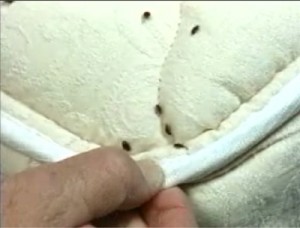A fall nuisance, boxelder bugs get their common name from the fact that they are often found on and around boxelder trees. The species is native to the western states; however, they can live wherever boxelder trees are—from eastern Canada throughout the United States to eastern Nevada. The bugs are primarily a nuisance pest as they enter structures, including homes, sheds, and garages to overwinter.
Boxelder Bugs Appearance
Boxelder bugs are black with orange to reddish markings on their back. Adult boxelder bugs have somewhat-flattened and elongated oval bodies and are about one half of an inch in length. They have six legs and two, non-segmented antennae that are typically half of their body length. Nymphs look similar in shape to the adults but lack wings and are bright red.
Infestation Signs
Boxelder bugs generally become a problem in the fall (and when they emerge in the spring) when they invade structures. Like many pests that overwinter, homeowners may see evidence of these bugs as the temperatures rise. This is when the insects emerge and go back outdoors.
Habits
Overwintering boxelder bugs emerge from hibernation in late March to early April when the boxelder tree buds open. During this time, the adults leave their hibernation sites to return to their host trees for the warmer months. They first feed on fallen boxelder seeds, later moving to the female boxelder trees where they will feed on the newly developing leaves. Occasionally, boxelder bugs will also feed on apple and plum trees.
The adult females lay clusters of straw-yellow eggs on stones, eaves, grass, shrubs, and trees; but especially in crevices in the bark of boxelder trees. The eggs will turn red as the embryos develop, hatching in about two weeks. The nymphs will feed on fallen boxelder seeds and then on freshly budded leaves. There are most commonly two generations per year in the warmer regions of the United States.
Threats
Inside, boxelder bugs are primarily just a nuisance pest; however, their fecal material can cause a red stain on curtains, drapes, clothing, etc. When crushed or handled roughly, boxelder bugs also produce a sharp, disagreeable odor.
Habitat
In autumn, boxelder bugs become gregarious and assemble on the south-facing side of trees, rocks, and buildings where the sun hits. After gathering in large masses, they will migrate to nearby homes or other structures to hibernate. They tend to hide in small crevices or cracks in walls to insulate themselves from the cold. In anywhere from late March to April, adults will leave their overwintering sites to return to their host trees for the warmer months.
Boxelder bugs are not known biters, but their piercing/sucking mouthparts can occasionally puncture the skin, producing a red spot similar to that of a mosquito bite.
How To Get Rid Of Boxelder Bugs
To prevent a boxelder bug infestation in your home or structure(s), be sure to repair holes in screens, seal crevices and cracks with a good quality silicone or silicone-latex caulk, and install door sweeps to all exterior entrances.
When getting rid of a boxelder bug infestation in homes or buildings, you should not make any attempt to eradicate them in wall voids. Insect carcasses can attract dermestid beetles (ie., carpet beetles, larder beetles, etc.). We recommend waiting until summer when all live adults have left the wall voids. To provide temporary relief, consider using a vacuum cleaner to get rid of the boxelder bugs. You should remove the bag to prevent the pests from escaping. Then, be sure to seal up all entryways into the living space – window and door frames, cracks in the baseboards, etc. – to prevent any future infestation. Remove the cover plate, seal and replace outlets, heating ducts, switch boxes, and air vents for electrical fixtures. For lights and ceiling fans, remove the fixture to its base plate, seal, and replace.
If you suspect a boxelder bug infestation, a licensed pest control professional should be contacted to evaluate and assess the problem.

